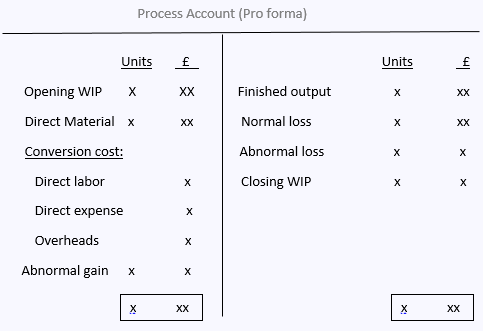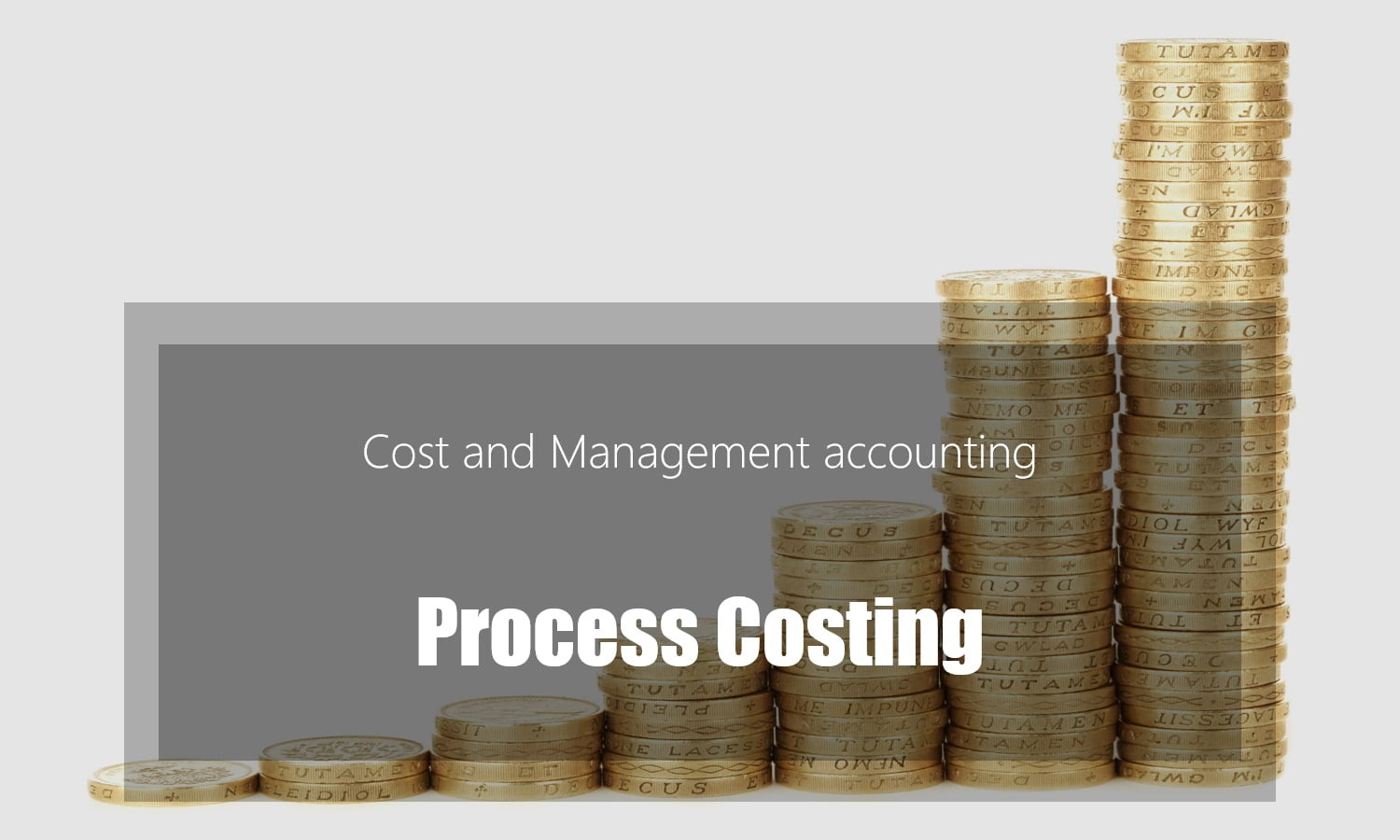Read more
- Introduction to Cost and Management Accounting
- High/Low and Linear Regression Analysis
- Inventory Management
- Accounting for Inventory
- Accounting for overheads
- Absorption Costing
- Marginal Costing
- Job Batch and Service costing
- Process Costing
- Target Costing
- Variances
- Standard Costing
- Cost Volume Profit analysis
- Relevant costing and Decision-Making Techniques
- Time Value of Money (TVM)
Process Costing Overview
- Process costing is used when output is produced in a continuous process system and it is difficult to separate individual units of output.

- It is not possible to have abnormal loss and gain on the same account in the same period.
- Whatever the complications, the task that sits at the heart of process costing is always to allocate the costs collected on the debit side of the account to possible output on the credit side.
- Basically we will need to:
- Identify the losses and output units.
- Calculate the cost of good output, losses and WIP.
- Use the costs calculated to assign to good output, losses and WIP (i,e units x cost)
- Complete the process account.
Losses
- It is the expected loss in processing and is usually expressed as a percentage of input units of materials.
- It is inherent in the process and is unavoidable.
Normal loss = material input – expected output
Normal loss with recovery/scrap value
- when losses in a process has scrap value then the company is able to recover some of input costs.
- The scrap value reduces overall cost of the process.
- In process account Normal loss is measured at scrap value.
Cost of output = Total process cost – scrap value
Expected output
Expected output = material input – normal loss
Normal loss without recovery/scrap value
- The cost of lost units is part of the cost of obtaining the good output.
- All of the cost should be assigned to the good output and none to the normal loss.
- It is given a NIL value when the loss has no scrap value.
- Disposal cost of normal loss is an addition to costs to the process and debited to process account. It is added to total process costs when calculating cost of good output.
Cost of output = Total process cost – scrap value
Expected output
- The difference between total actual loss and normal loss is ‘abnormal loss’.
- Abnormal loss is not expected and given a cost.
- If it is assumed that losses occur at the end of process, units of abnormal loss are costed exactly as finished output units i,e cost per units of abnormal loss is same as cost of units of good output
Cost of output = Total process cost – scrap value
Expected output
- Abnormal loss is treated as an expense and charged in Income Statement.
Abnormal Gain
- The difference between normal loss and the total actual loss, where the actual loss is less then normal loss.
Abnormal Gain = Normal loss – Actual loss
- Abnormal gain is a benefit rather than a cost.
- Abnormal gain is an adjustment the increases the profit for the period.
- It is recorded as a debit entry.

Abnormal Gain where loss has NO scrap value
- If it is assumed that all losses occur at the end of the process, the cost per unit of finished output and the value/cost of abnormal gain is calculated as the cost per expected unit of output.
- The cost per unit of abnormal gain is therefore the same as the cost of units of good output.
Cost of output = Total process cost – scrap value
Expected output
Abnormal Gain where loss has a scrap value
- When loss has a scrap value, the value of abnormal gain is actually less than the amount shown in the process account. As the balance on the abnormal gain account is netted off by the scrap value.
- The balance is transferred as a net benefit to the Income Statement.
Losses and Gains at different stages in the Process
- If it is assumed that losses occur at the end of the production process, units of abnormal loss or gain are given a cost or value as if they are fully completed units and so one equivalent unit each. But is no relevant for normal loss.
- However, if losses occur at a different stage in the process, this assumption of differing degrees of completion is used for direct material and conversion, instead the concept of equivalent unit is used to decide the cost of abnormal loss/gain.
When loss occurs part-way through a process, the cost of any abnormal loss is calculated:
- establishing the equivalent units of direct material and conversion costs for loss.
- calculating a cost per equivalent units.
- using the calculations of equivalent units and cost per equivalent units to obtain a cost for finished output and abnormal loss in period.
The same principles apply to the valuation of abnormal gain, where the gain occur part-way through the process as abnormal loss.
However there is one important difference, equivalent units of abnormal gain are given a Negative value and subtracted from the total equivalent units of output in the period.
Work in Progress Balance
Work in Progress Balance

Opening Work in Progress
- When there is opening WIP there are two types of costs on the debit side. The opening WIP and the cost incurred in current period.
- The issue is whether these type of costs should be treated together or separately. The question is addressed in the accounting policy adopted for opening WIP. The following are two policies adopted:
weighted average cost method
- When this is used the assumption is that all units produced during the period and all units in closing inventory should be valued at the same cost per equivalent units for materials and conversion i,e an average cost per equivalent unit is calculated for all units of output and closing inventory.
- A three stage calculation is used:
- Prepare statement of equivalent units.
- Prepare statement of cost per unit equivalent units
- Prepare statement of evaluation.
FIFO cost method
- Based on the assumption that the opening WIP are the first units completed. It is necessary to calculate the number of equivalent units for:
-
- WIP opening
- Finished output
- WIP closing
- The three stage calculation is used for equivalent units and cost allocation.
- The three stage calculation is similar as weighted average with the exception that in statement of evaluation finished output consists of:
-
- The finished cost of opening WIP is the sum of: costs in opening WIP value at start of period PLUS cost incurred in current period to complete these units PLUS the cost of finished output started and finished in the period.
- Closing WIP means some units have been started and finished in the year and others have been started but not finished.
- It stands to reason that cost/value of an unfinished unit is less than the cost of a completed unit. The cost of the process must be shared between finished output and unfinished WIP. In order to do this the concept of equivalent is used.
- A three stage calculation:
- Prepare statement of equivalent units.
- Prepare statement of cost per unit equivalent units.
- Prepare statement of evaluation.
Joint Products and By-Products
Process costing
Joint Products and By-Products

Joint Products
Joint products are two or more products generated simultaneously, by a singe manufacturing process, using common input, and being substantially equal in value.
Apportioning common processing costs
- The costs of the common process that produces the Joint products are common costs. They must be apportioned between Joint products.
One of the following methods is used:
Units Basis
Common costs are apportioned on basis of total number of units produced.
Sales value at split-off point
Common costs are apportioned on basis of the sales value of Joint product produced when they are separated in process.
Net realizable value
Common costs are apportioned on basis of the sales value of Joint product produced when they are separated in process.
When two or more different products are produced. Any product that does not have a substantial sales value and relatively minor in quantity is called a by-product.
Treatment of By-Product
Any of following method is used:
- Adding it to revenue from sales. No cost is allocated to by-product.
- As other income. No cost is allocated to by-product.
- As a deduction from Joint process costs (the most common method used).
-
- By-product is measured at scrap value, similar to normal loss.


Leave a Reply
You must be logged in to post a comment.